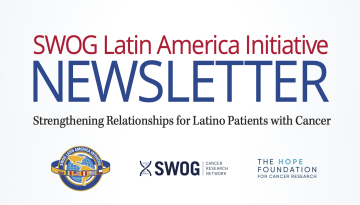Lung-MAP: Bending the Arc Toward More Representative Research
SWOG's Lung Master Protocol (Lung-MAP) is not only the NCTN's first precision medicine trial in lung cancer, it's also the product of a unique public–private partnership that has thrived for almost a decade now.
SWOG biostatistician Riha Vaidya, PhD, and her Lung-MAP colleagues wanted to learn whether a biomarker-driven umbrella trial built on such a partnership could foster more representative enrollment than conventional clinical trials, particularly among groups historically underrepresented in research studies.
To answer that question, they dove into the sociodemographic data on all 3,556 patients enrolled to Lung-MAP, from the trial’s opening in 2014 through the end of 2020, comparing the characteristics of those patients to comparable data on 2,215 patients who had enrolled to other SWOG studies in non-small cell lung cancer (NSCLC).
Their analysis of the representativeness of the Lung-MAP patient population was published earlier this month in JCO Precision Oncology. (You can also read our press release on the publication.)
They learned that, compared to patients on individual SWOG trials in NSCLC, Lung-MAP patients were more likely to be 65 years of age or older (57.2 percent versus 46.3 percent), to live in a rural area (17.3 percent versus 14.4 percent), to live in a neighborhood classified as socioeconomically deprived based on its Area Deprivation Index score (42.2 percent versus 36.7 percent), or to have Medicaid insurance or no health insurance (27.6 percent versus 17.8 percent of patients younger than 65).
An editorial published this week in the same journal highlights the implications of the Lung-MAP paper’s findings. It’s titled “Clinical Trial Diversity: A Bend in the Arc Toward Justice,” and it’s authored by Susan H. Tannenbaum, MD, and Jennifer E. Miller, PhD, of the University of Connecticut and Yale University schools of medicine, respectively.
The editorial cites the Lung-MAP team for taking a “multidimensional approach to conceptualizing adequate diversity, beyond sex, age, race, and ethnicity, to include other variables related to patients’ geographic location and socioeconomic status.”
In discussing the need to make industry-funded trials more representative, it reminds us that previous research (led by yet another SWOG biostatistician – Joseph Unger, PhD) had already demonstrated that NCTN trials were enrolling significantly higher percentages of Black patients, on average, than industry-sponsored trials, providing context for potential additional benefit from Lung-MAP-type partnerships between industry and our publicly funded trials network.
The editorial’s authors conclude, “Efforts like those of Lung-MAP, an innovative public-private collaboration … should help bend the arc toward more accessible and representative research.”
As with most of our publications that mark progress, the representativeness paper by Dr. Vaidya and colleagues also measures the distance we still have to go. For example, Lung-MAP did a slightly better job than our other NSCLC trials of enrolling Black patients (9.3 percent versus 8.2 percent of accrued patients), but the difference was not statistically significant, and we still have much to do to reach our larger goal of having Lung-MAP enroll Black patients at a rate that matches their prevalence in the overall U.S. population of patients with advanced NSCLC (14.1 percent).
Still, it is important to recognize progress – to learn from it, and to build on it.
The Lung-MAP paper does just that – detailing progress and giving us new signposts for the road ahead. Lung-MAP continues to thrive. We’re likely to see at least two more sub-studies launched this fall, and the S2302 Pragmatica-Lung follow-on to Lung-MAP S1800A is enrolling briskly – with Black patients comprising 12 percent of total enrollment at this point. We continue our work to make Lung-MAP accessible to all patients with advanced NSCLC.
The Tannenbaum and Miller editorial recognizes the promise inherent in the Lung-MAP representativeness report and the Lung Master Protocol endeavor overall:
"For FDA drug and biologic approvals and our medical evidence to be equitable, there needs to be fair inclusion of women, older adults, and ethnic, racial, and other under-represented groups (URM) in clinical trials. In the article that accompanies this editorial, Representativeness of Patients Enrolled in the Lung Cancer Master Protocol (Lung-MAP), Vaidya et al demonstrate a way forward to accomplish this."
Let’s follow that way forward.
________________________________________________________________
Trial of the Week
S2013: Immune CHECKpoint Inhibitor Toxicity (I-CHECKIT): A Prospective Observational Study
The primary objective of the S2013 I-CHECKIT trial is to develop and validate a risk prediction model for immune-related adverse events (irAEs) patients can suffer after treatment with immune checkpoint inhibitors.
The trial’s focus is non-hematological irAEs that are Grade 3 or higher and occur in the first year of checkpoint therapy – monotherapy or combination checkpoint therapy – for solid tumors.
Secondary objectives also look at the incidence of hematological irAEs of Grade 4 or higher and at the trends of quality-of-life indicators and other patient-reported outcomes over time.
Patients with a wide range of solid tumors are eligible, and as an observational study, the trial is a relatively simple one for sites to take part in and accrue to.
The study activated in the summer of 2021, and to date, 1,412 patients have been enrolled, at 178 sites, while almost 700 sites have opened the trial. The overall enrollment goal is 2,062 patients.
Cancer Care Center of O’Fallon (part of the Heartland Cancer Research NCORP) and Oncology Associates at Mercy Medical Center (part of the Iowa-Wide Oncology Research Coalition NCORP) are the leading accruers to the study.
The study chair is Krishna Gunturu, MD, of Lahey Hospital and Medical Center.
You can learn more on the SWOG S2013 page or the CTSU S2013 page. A patient-friendly plain language trial summary, CIRB-approved, is also available for introducing your patients to the study (also as a printable PDF).
Other Recent Stories



